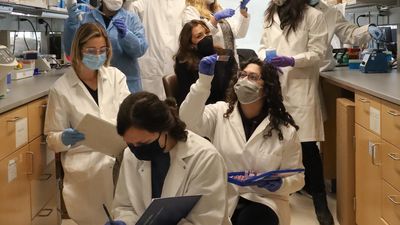The quest for an elixir to restore youthful health and vigor is common to most cultures and has prompted much scientific research. About a decade ago, Stanford scientists stitched together the blood circulatory systems of old and young mice in a practice called parabiosis. It seemed to rejuvenate the aged animals and spawned vampirish urban legends of Hollywood luminaries and tech billionaires paying big bucks for healthy young blood to put into their own aging arteries in the hope of reversing or at least forestalling the aging process.
It was “kind of creepy” and also inspiring to Fabrisia Ambrosio, then thousands of miles away and near the start of her own research career into the processes of aging. Her lab is at the University of Pittsburgh but on this cold January morning I am speaking with her via Zoom as she visits with family near her native Sao Paulo, Brazil. A gleaming white high rise condo and a lush tropical jungle split the view behind her, and the summer beach is just a few blocks away.
Ambrosio possesses the joy of a kid on Christmas morning who can't wait to see what’s inside the wrapping. “I’ve always had a love for research, my father was a physicist," she says, but interest in the human body pulled her toward biology as her education progressed in the U.S. and Canada.
Back in Pittsburgh, her lab first extended the work of others in aging by using the simpler process of injecting young blood into the tail vein of old mice and found that the skeletal muscles of the animals “displayed an enhanced capacity to regenerate.” But what was causing this improvement?
When Ambrosio injected old mice with young blood depleted of EVs, the regenerative effect practically disappeared.
The next step was to remove the extracellular vesicles (EVs) from blood. EVs are small particles of cells composed of a membrane and often a cargo inside that lipid envelope. Initially many scientists thought that EVs were simply taking out the garbage that cells no longer needed, but they would learn that one cell's trash could be another cell's treasure.
Metabolites, mRNA, and myriad other signaling molecules inside the EV can function as a complex network by which cells communicate with others both near and far. These cargoes can up and down-regulate gene expression, affecting cell activity and potentially the entire body. EVs are present in humans, the bacteria that live in and on us, even in plants; they likely communicate across all forms of life.
Being inside the EV membrane protects cargo from enzymes and other factors in the blood that can degrade it, says Kenneth Witwer, a researcher at Johns Hopkins University and program chair of the International Society for Extracellular Vesicles. The receptors on the surface of the EV provide clues to the type of cell from which it originated and the cell receptors to which it might later bind and affect.
When Ambrosio injected old mice with young blood depleted of EVs, the regenerative effect practically disappeared; purified EVs alone were enough to do the job. The team also looked at muscle cell gene expression after injections of saline, young blood, and EV-depleted young blood and found significant differences. She believes this means that the major effect of enhanced regenerative capacity was coming from the EVs, though free floating proteins within the blood may also contribute something to the effect.
One such protein, called klotho, is of great interest to researchers studying aging. The name was borrowed from the Fates of Greek mythology, which consists of three sisters; Klotho spins the thread of life that her sisters measure and cut. Ambrosio had earlier shown that supplementing klotho could enhance regenerative capacity in old animals. But as with most proteins, klotho is fragile, rapidly degrading in body fluids, or when frozen and thawed. She suspected that klotho could survive better as cargo enclosed within the membrane of an EV and shielded from degradation.
So she went looking for klotho inside the EVs they had isolated. Advanced imaging technology revealed that young EVs contained abundant levels of klotho mRNAs, but the number of those proteins was much lower in EVs from old mice. Ambrosio wrote in her most recent paper, published in December in Nature Aging. She also found that the stressors associated with aging reduced the communications capacity of EVs in muscle tissue and that could be only partially restored with young blood.
Researchers still don't understand how klotho functions at the cellular level, but they may not need to know that. Perhaps learning how to increase its production, or using synthetic biology to generate more copies of klotho mRNA, or adding cell receptors to better direct EVs to specific aging tissue will be sufficient to reap the anti-aging benefits.
“Very, very preliminary data from our lab has demonstrated that exercise may be altering klotho transcripts within aged extracellular vesicles" for the better Ambrosio teases. But we already know that exercise is good for us; understanding the cellular mechanism behind that isn't likely to provide additional motivation to get up off the couch. Many of us want a prescription, a pill that is easy to take, to slow our aging.
Ambrosio hopes that others will build upon the basic research from her lab, and that pharmaceutical companies will be able to translate and develop it into products that can pass through FDA review and help ameliorate the diseases of aging.
